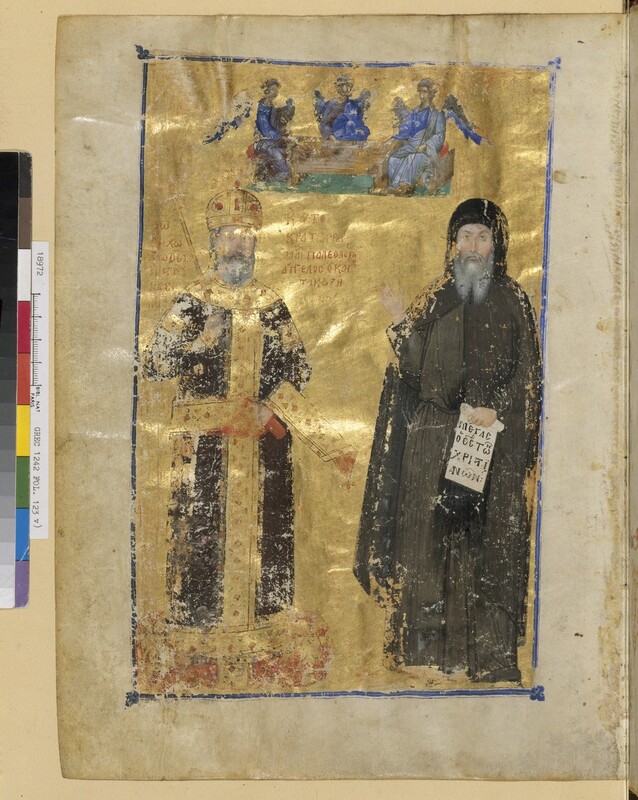Theological works of John VI Kantakouzenos
Type:
Illuminated manuscripts
Date:
1370–75
Location or Findspot (Modern-Day Country):
Turkey
Dimensions:
33.5 × 25 cm
Description:
John VI Kantakouzenos was Byzantine emperor (r. 1347–54; d. 1383) during a period of civil strife; when he was forced to step down, he became a monk with the name Ioasaph. During his monastic “retirement,” he wrote his memoirs, treatises against Judaism and Islam, and theological works promoting the late Byzantine spiritual movement known as hesychasm. These works are preserved in a deluxe manuscript of 437 folios now in Paris, Bibliothèque nationale de France, MS gr. 1242.
The Transfiguration image (fol. 92v) faces one of the fourth-century theologian St. Gregory of Nazianzos (on fol. 93r). This pair comes in the middle of one of John VI’s letters, written ca. 1368 to the Latin patriarch of Constantinople; there had been a Roman-rite patriarch in the city since the 1204 conquest. In the letter, John defended hesychasm and its practitioners’ attempts to unite with God by means of a vision of uncreated, divine light, which prefigures the eternal light that will be the reward of righteous Christians after Christ’s Second Coming. The images accompanying the letter help justify its contents. Gregory is shown seated against a shimmering gold background; below are lines from his orations that illuminate the Transfiguration scene. They begin: “The light, which was the divinity shown to the disciples on the mountain, was almost too strong to be seen.” These lines were often cited in fourteenth-century hesychast writings because they provided an authoritative source for this controversial idea.
Several councils held in Constantinople in the mid-fourteenth century defended hesychastic doctrines. On fol. 5v, the emperor is shown in ceremonial regalia presiding over the council held in 1351 at the imperial palace at Blachernae.
Fol. 123v is a double portrait showing John VI as both emperor and monk. Inscribed in red on both sides of the head of the emperor is “John in Christ God, faithful basileus [emperor] and autokrator [sole ruler] of the Romans Palaiologos Angelos Kantakouzenos." On the scroll held by the monk (and former emperor) is "“Great is the God of the Christians," the opening sentence of his treatise against Islam.
The Transfiguration image (fol. 92v) faces one of the fourth-century theologian St. Gregory of Nazianzos (on fol. 93r). This pair comes in the middle of one of John VI’s letters, written ca. 1368 to the Latin patriarch of Constantinople; there had been a Roman-rite patriarch in the city since the 1204 conquest. In the letter, John defended hesychasm and its practitioners’ attempts to unite with God by means of a vision of uncreated, divine light, which prefigures the eternal light that will be the reward of righteous Christians after Christ’s Second Coming. The images accompanying the letter help justify its contents. Gregory is shown seated against a shimmering gold background; below are lines from his orations that illuminate the Transfiguration scene. They begin: “The light, which was the divinity shown to the disciples on the mountain, was almost too strong to be seen.” These lines were often cited in fourteenth-century hesychast writings because they provided an authoritative source for this controversial idea.
Several councils held in Constantinople in the mid-fourteenth century defended hesychastic doctrines. On fol. 5v, the emperor is shown in ceremonial regalia presiding over the council held in 1351 at the imperial palace at Blachernae.
Fol. 123v is a double portrait showing John VI as both emperor and monk. Inscribed in red on both sides of the head of the emperor is “John in Christ God, faithful basileus [emperor] and autokrator [sole ruler] of the Romans Palaiologos Angelos Kantakouzenos." On the scroll held by the monk (and former emperor) is "“Great is the God of the Christians," the opening sentence of his treatise against Islam.
Relevant Textbook Chapter(s):
10
Repository and Online Resources:
• See the complete manuscript on the Gallica website.
• Watch a short video in French about the manuscript.
Image Credits:
Bibliothèque nationale de France




